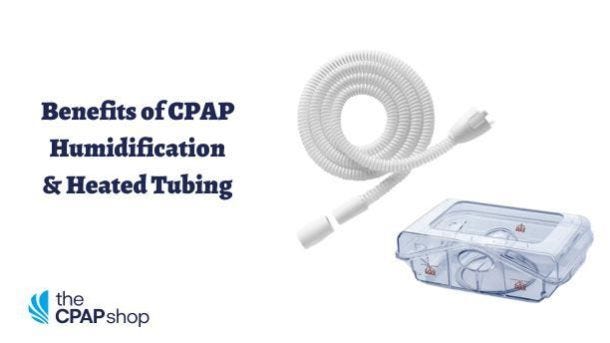Benefits of Using CPAP Humidification and Heated Tubing
Patients with sleep apnea who use CPAP machines for more than four hours a night enjoy a good night’s sleep and also improve their quality of life. Some sleep apnea patients, unfortunately, find that staying committed to the CPAP treatment process can be a difficult proposition. In particular, it is not uncommon for patients to experience dryness of the mouth, throat, or nasal passage . This dryness tends to make the transition to CPAP therapy more challenging than it otherwise would be. This post will not attempt to resolve all CPAP compliance issues, but many compliance issues can be resolved by increasing the humidity during therapy. For instance, air delivered via CPAP averages around 20% lower in humidity than one would find in an average room. In many cases, CPAP humidification and heated tubing have been shown to improve patient comfort and compliance with CPAP therapy.
Why CPAP Humidification and Heated tubing are Recommended
When first beginning CPAP therapy without humidification, as many as 40% of patients experience problems like dry throat and nasal passages, congestion and even nosebleeds (1). Sometimes congestion and nosebleeds can be from allergies, rhinitis, or sinusitis, but in many cases adding CPAP humidification and better tubing can alleviate these conditions since they are a side effect of breathing dry, pressurized air. Fortunately, CPAP humidifiers are responsible for alleviating these issues. When you use a CPAP machine, pressurized air constantly passes through your airways. As a result, therapy can dry out your nasal passageway or cause irritation. A humidifier adds moisture to the airflow, which reduces the harshness of the air stream and prevents irritation.
Even with a humidifier, patients can still experience dryness and inflammation due to the ambient room temperature. If the room temperature is cold and no heated humidifier is being used, the airflow through the mask will be cold as well. Constant cold air can cause a sore throat or other discomfort. Luckily, heated CPAP humidification and heated tubing can remedy this problem. Heating up the air as it passes through the humidifier’s water chamber will be highly beneficial. In most cases, the combination of heat and moisture alleviates nasal congestion and dry mouth caused by CPAP therapy.
Types of CPAP Humidification
Most new CPAP machines with the exception of small, travel units, have integrated humidification. These units can provide both warm and room temperature humidification through manual controls. Each person is different so it’s best to experiment with the temperature setting on the humidifier. For travel units, an in-line filter can help by capturing humidification from exhaling and return it back as moisture. Fortunately, the most popular travel unit, the Philips DreamStation Go addresses the humidification issue with a new integrated humidifier which will launch by the end of 2018.
CPAP patients have the option of heated or cold pass-over humidification or no humidification at all. They can experiment and choose their best personal solution.
Manufacturers Make it Easy to Add CPAP Humidifiers and Heated Tubing
Many machines today already come with a built in humidifier, such as the ResMed AirSense 10, and the Philips DreamStation. Others, like the DeVilbiss IntelliPAP, have a removable humidifier that enables the user to choose not to use the humidifier.
However, if you find you still struggle with dryness and irritation, a heated tube added to the circuit can improve humidification efficiency. Heated tubing maintains the warm temperature of the air as it travels from the humidifier’s water chamber up to the mask. Using heated tubing can counter irritation and dryness in even the most sensitive patients.
Another benefit of Heated Tubing with CPAP Therapy
Surprisingly enough, heated tubing has another benefit as well. When heated air travels from a heated humidifier and cools in a conventional tube, condensation collects on the inside of the tube. If enough water collects in the tube, it can flow up into the CPAP mask. This sudden splash of water in the nose or mouth is also known as rainout and can be annoying. Heated tubing helps to prevent this unpleasant shock by maintaining the warm temperature of the air within the tube. Machines like the Philips Respironics DreamStation have optional heated tubing and heated humidifier accessories that can offset the risk of rainout.
Cleaning the Chamber and Tubing is important too!
It is always important to clean your CPAP equipment. In particular, the water chamber and tubing are two of the areas which really need cleaning focus. With water and moisture in the chamber and tube, if uncleaned, it is ripe for bacteria and mildew. This can cause upper respiratory issues or extend colds longer than normal. Thus, it is important to constantly clean these accessories. Fortunately, There are easy and convenient ways to clean these products. Certainly, using a vinegar and water solution is the easiest but also can be time consuming. For people who like to set it and forget it, there are solutions such as the Lumin and SoClean2 that make CPAP cleaning a breeze.
CPAP Humidification and Heated Tubing Improve Compliance for Many
Humidification and heated tubing can truly improve an individual’s CPAP therapy experience. Without dryness, congestion or irritation, CPAP therapy users are much more likely to remain compliant and use their machine every night. Consistent use of your CPAP device is key to treating sleep apnea and ensuring you receive plenty of sleep each night. If you have trouble with some of the side effects of using a CPAP machine, humidifiers and heated tubing can deter those issue and help you get on the right track with your sleep apnea treatment.
(1) 2. Richards D, Cistulli R, Unger R, Berthon-Jones M, Sullivan C. Mouth leak with nasal CPAP increases nasal airway resistance. Aust NZ J Med. 1994;24:480.
Chris Vasta is the president of The CPAP Shop and an expert in sleep and respiratory therapy. He often provides insights on product design and functionality on various manufacturers’ prototypes and is frequently tapped to provide reviews on new releases.
This post was originally published on August 30, 2018 and updated on August 29, 2023.




